Some milestones in our understanding of yeast culture supplementation in ruminants and their implications in animal production systems
Production responses to a specific yeast culture, Yea-Sacc1026
The effects of specific yeast culture preparations on performance of ruminants have been well documented over the last two decades. Production responses have been measured in both dairy and meat production systems. Typically, two different approaches have been used to examine production responses to the yeast culture (Yea-Sacc) in dairy cattle. The first uses experimental designs that compare milk production in animal groups receiving the yeast culture supplement with those of control groups receiving unsupplemented diets (Table 1). These types of studies allow for careful evaluation of effects of yeast preparation under controlled conditions, but only use limited numbers of animals. Such studies clearly show responses to yeast supplementation strategies. The second experimental approach uses field studies to demonstrate the effects of yeast culture supplements by comparing milk production during a supplementation period with that observed during a similar period when the animals receive an unsupplemented diet (Table 2). Such field studies often are much less controlled and require an understanding of many of the factors that influence animal production during a normal production cycle. However, they do allow for the evaluation of yeast culture preparation under conditions that reflect practical field application in large numbers of animals.
In 22 studies with Yea-Sacc involving more than 9039 dairy animals, supplementation resulted in an average increase in milk production of 7.3%. Responses to supplementation were variable but ranged from a 2% increase to a 30% increase in milk production. Similarly, growth responses to yeast culture in meat-producing animals have been observed. These responses to yeast cultures in growing ruminant animals have also been variable and range from no significant increase in average daily gain to increases of more than 20%. An average increase in daily gain was 8.7%. These studies indicate that management practices, diets and overall stress influence responses to yeast culture supplementation. However, data from a wide range of both controlled studies and field trials suggest that yeast culture supplements can have a significant role in strategies for economically enhancing the performance of ruminant animals.
Table 1. Milk production responses to Yea-Sacc supplementation in animals assigned to specific treatment groups.

To enlarge the imagen, click here
*Significant difference (P<0.05).
Effects of yeast cultures on the rumen
Many laboratories have examined the effects of yeast cultures on microbial activities in the rumen. In order to develop a model for explaining the effects of yeast on animal performance, it is important to review some the research milestones that have helped define the role of yeast in the rumen.
MILESTONE #1- YEAST SUPPLEMENTATION INFLUENCES RUMINAL DIGESTION
Most investigators agree that yeast culture supplementation strategies can have measurable effects on ruminal fermentations, and a number of beneficial changes in digestion have been noted. Studies in several laboratories have demonstrated that yeast culture supplementation can influence digestive processes in the rumen (Williams and Newbold, 1990; Dawson, 1992; Newbold et al., 1996; Wallace 1996). Typically, the total extent of dry matter digestion was not drastically altered. However, the initial rate of digestion is readily influenced by the addition of live yeast preparations to the diets of ruminants (Figure 1). This is a characteristic of yeast supplementation that has been measured in both in vitro (Dawson and Hopkins, 1991) and in vivo studies (Williams and Newbold, 1990; Smith et al., 1993; Kumar et al., 1997). Since feed intake is often considered to be a function of the initial rates of fiber digestion, early stimulation of ruminal activity can be expected to have a major impact on feed consumption and can provide a drivingforce for improved animal performance. Such studies suggest an important role for yeast culture supplementation in digestion of animals maintained on high forage diets.
Table 2. Field trials comparing milk production before and after Yea-Sacc supplementation.
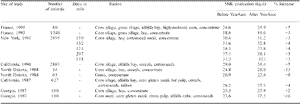
To enlarge the imagen, click here
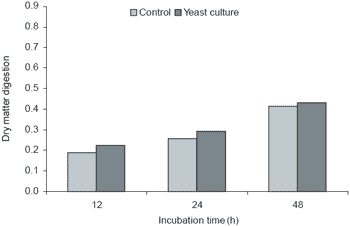
Figure 1. Effects of Yea-Sacc on in sacco dry matter digestion by ruminal bacteria (adapted from Kumar et al., 1997).
MILESTONE #2- YEAST CULTURE SUPPLEMENTATION INFLUENCES RUMINAL LACTIC ACID METABOLISM
Other studies have demonstrated a role for yeast culture in stabilizing ruminal fermentations and in addressing ruminal disorders. Williams et al. (1991) demonstrated the beneficial effects of the viable yeast culture, Yea-Sacc, on lactic acid concentrations in the rumen in high concentrate diets (Figure 2). In animals fed high energy diets, decreased lactic acid concentrations are associated with higher ruminal pH and are characteristic of much more stable ruminal fermentation. These alterations in ruminal fermentation can be expected to provide for improved digestion and could also be reflected in improved intake and production. The ability of yeast to prevent the accumulation of lactic acid in the rumen suggests a role for viable yeast in overcoming ruminal dysfunctions associated with the use of high energy diets used in both high-producing dairy and fast-growing beef cattle.
MILESTONE #3- YEAST CULTURE SUPPLEMENTATION ALTERS RUMINAL NITROGEN METABOLISM
Several lines of evidence suggest that yeast culture supplementation can beneficially alter nitrogen metabolism in the rumen (Table 3). This is reflected in lower ruminal ammonia concentrations observed in animals receiving yeast supplements and is consistent with observed increases in the concentrations of bacteria in the rumen. In addition, these changes are reflected in an increased flow of bacterial nitrogen to the small intestines (Erasmus et al., 1992). Altered nitrogen flow has also been associated with shifts in the basic amino acid flow out of the rumen. The beneficial increase in the flow of microbial protein from the rumen is consistent with models that suggest stimulation of microbial growth in the rumen and more efficient conversion of ammonia nitrogen into microbial protein. Since microbial protein is often used to drive protein synthesis in high-producing ruminants, these observations suggest a role for specific yeast culture supplements in stimulating protein synthesis in both beef and dairy production systems.
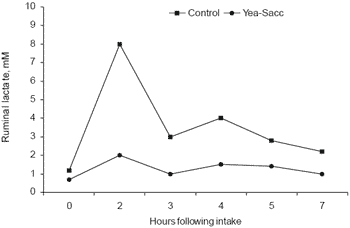
Figure 2. Effect of Yea-Sacc on the concentration of lactic acid in the rumen (adapted from Williams et al., 1991).
Table 3. Effects of Yea-Sacc on nitrogen intake and the flow of nitrogen to the small intestine of a lactating dairy cow.
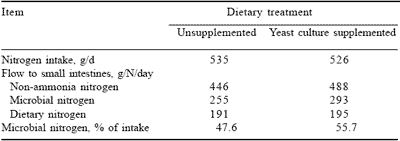
(adapted from Erasmus et al., 1992).
MILESTONE #4- YEAST SUPPLEMENT ALTERS RUMINAL MICROBIAL POPULATIONS
Many investigators have attributed the beneficial effects of yeast culture directly to changes in the ruminal fermentation and to changes in the microbial population in the digestive tract (Williams and Newbold, 1990; Dawson, 1992; Newbold et al., 1996; Wallace, 1996). The ability of specific yeast culture preparations to stimulate the growth of ruminal bacteria and to increase the concentrations of specific groups of beneficial bacteria in the rumen has been well documented (Table 4). Increased concentrations of the total anaerobic bacteria and of cellulolytic bacteria have been one of the most consistently measured responses to yeast culture in the rumen (Wiedmeier et al., 1987; Harrison et al., 1988; Dawson et al., 1990; Newbold and Wallace, I992).
However, other studies have also suggested that yeast culture preparations can enhance the growth of lactic acid-utilizing bacteria (Edwards, 1990; Girard et al., 1993), proteolytic bacteria (Yoon and Stern, 1996) and bacteria that convert molecular hydrogen to acetate in the rumen (Chaucheyras et al., 1995b). In addition, yeast preparations have been shown to enhance the activities of fiber-digesting fungi in the rumen (Chaucheyras et al., 1995a). Increased concentrations of beneficial microorganisms and enhanced microbial activities can be expected to lead to enhanced digestive processes and the destruction of metabolic intermediates that can result in ruminal dysfunction. The ability of yeast to stimulate specific groups of bacteria is consistent with many of the other physiological and metabolic effects of yeast observed in the rumen and can explain enhanced protein synthesis, improved ruminal stability and improved microbial protein synthesis.
Table 4. Effects of yeast culture supplements on the concentrations of selected bacteria in ruminal microbial populations.
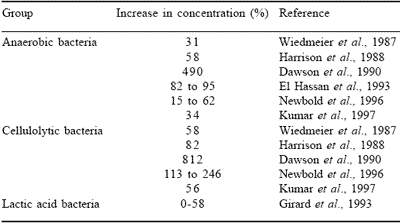
MILESTONE #5- NOT ALL YEAST STRAINS HAVE THE SAME STIMULATORY ACTIVITIES
Several studies have demonstrated that not all yeast strains are capable of stimulating ruminal bacteria. Evidence for strain difference has been obtained from studies with pure cultures of ruminal bacteria and with mixed populations. Only seven of over 50 strains tested had the ability to stimulate the growth of fiber-digesting bacteria from the rumen (Dawson and Hopkins, 1991). In addition, other studies suggest that few strains of yeast have the ability to stimulate both the beneficial fiber-digesting bacteria and the bacteria associated with lactate utilization. Similarly, Newbold et al. (1996) demonstrated that brewer’s yeast strains and baker’s yeast strains differed in their abilities to stimulate critical groups of ruminal microorganisms (Figure 3). Baker’s yeast strains had limited ability to bring about stimulation. These studies suggest that care must be taken in selecting Saccharomyces cerevisiae strains for use as feed supplements for ruminants. Such studies also explain some of the variability in production responses since many of the early studies relied on poorly defined yeast culture supplements.
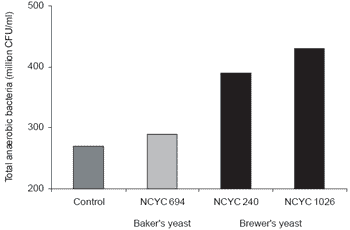
Figure 3. Effects of several yeast strains on the concentrations of bacteria in a mixed ruminal population (adapted from Newbold and Wallace, 1992).
MILESTONE #6- METABOLICALLY ACTIVE YEAST CELLS ARE NEEDED FOR STIMULATORY ACTIVITIES
The importance of viable or metabolically active yeast cells in a yeast culture preparation for optimal stimulatory activity in the rumen has been established by a number of investigators. Autoclaved yeast preparations are ineffective at increasing the numbers of viable bacteria in the rumen (Dawson et al., 1990; El Hassan et al., 1993). However, irradiated yeast cells that cannot reproduce but maintain their metabolic activities have been successfully used to stimulate beneficial ruminal bacteria (El Hassan et al., 1993). These studies suggest that metabolic activity and not active reproduction are an integral part of the basic process leading to a maximal beneficial response to yeast culture. This requirement for metabolically active yeast cells should be considered in any model used to explain the overall effects of yeast in the rumen.
Biochemical basis explaining the stimulatory effects of yeast in the rumen
Despite the basic understanding of some of the beneficial effects of yeast cultures on the bacterial population in the rumen, the physiological basis for the enhanced microbial growth has not been completely described. A number of specific hypothetical biochemical mechanisms have been developed to explain the stimulatory effects of yeast cultures in the rumen (Dawson and Girard, 1997). Some of these have been based on the ability of yeast to provide important nutrients or nutritional cofactors that stimulate microbial activities while others suggest that the ability of yeast to control the oxygen level in the ruminal environment is important. These kinds of models have many attractive features but are individually limited in their ability to explain all of the effects associated with yeast supplementation in the rumen.
However, recent studies have suggested that more basic mechanisms are involved in the overall stimulation of beneficial ruminal bacteria (Girard, 1996; Girard and Dawson, 1994; 1995). These studies have resulted in the isolation of a group of small compounds that stimulate bacteria to enter into logarithmic growth and thus stimulate microbial activities. Some of the basic characteristics of these stimulatory compounds are consistent with the basic characteristics of small biologically active peptides (Table 5). The stimulatory activities of these small peptides has been demonstrated in studies with pure cultures of ruminal bacteria (Girard, 1996). Synthetic tryptophancontaining peptides have also been shown to bring about similar stimulatory effects and have also been shown to stimulate the growth of representative fiber-digesting bacteria from the rumen. These stimulatory activities were not associated with individual amino acids (Table 6). Stimulatory activities occurred at concentrations well below those that would suggest that these compounds are limiting nutrients. Instead, they appear to serve as metabolic triggers that stimulate beneficial ruminal bacteria to enter into an exponential growth phase. This stimulatory activity toward specific strains of ruminal bacteria can explain many of the observed effects of yeast culture in the rumen. A hypothetical model explaining the action of the yeast-derived peptides in the rumen is outlined in Figure 4.
Table 5. Characteristics of low-molecular weight stimulatory factors from culture supernatants.
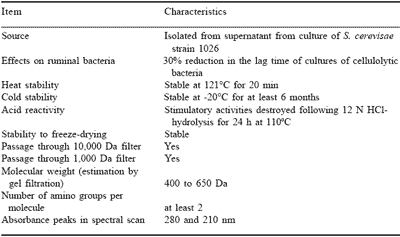
Table 6. Stimulatory effects of L-tryptophan and individual peptide preparations on the lag time of cultures of R. albus 7.

aCultures of R. albus were supplemented with each of the preparations or with water. Peptide preparations provided 40 nmoles of peptide per L. Stimulation is indicated by a reduction in the time required to initiate growth (lag time).
b,c,d,e,fMeans (n = 3) in a column lacking a common superscript differ (P < 0.10). SEM = 0.15 h.
The stimulatory peptides are apparently not stable in the ruminal environment. Attempts to measure their presence in rumen fluid have been unsuccessful. Activities of proteolytic enzymes and rapid uptake of the peptides by microorganisms probably eliminates these compounds from the rumen very rapidly. This observation is consistent with the requirements for metabolically active yeast preparation that have been observed by a number of investigators (Dawson et al., 1990; El Hassan et al., 1993). It is possible that the metabolically active cells provide a continuous source of such peptides and thus can continually provide low levels of stimulation for beneficial ruminal bacteria. Taken together, these observations suggest that the stimulatory effects of yeast in the rumen can be at least partially explained by the presence of these biologically active compounds.

Figure 4. Model explaining the ability of specific peptides to alter microbial growth and ruminal fermentations.
Other potential activities of yeast cultures in the rumen
It is important to recognize that stimulatory effects of viable yeast in the rumen only address some of the beneficial effects of yeast in animal production systems. Research in this area has resulted in a number of new concepts that have evolved into useful animal supplements. Currently yeast cell wall products are available that prevent colonization by pathogenic microorganisms in the gut, alter the composition of microbial populations in the intestinal tract, modulate immune function and alter the structure of the gut wall. These developments are all the result of in depth study of yeast culture supplementation and are currently used to enhance the performance of both ruminant and non-ruminant animals.
Conclusions
The research has demonstrated that viable yeast cell preparations can stimulate specific groups of beneficial bacteria in the rumen and has provided mechanistic models that can explain the effects of yeast on animal performance. Continuous research with yeast culture supplements has clearly established scientifically proven strategies for modifying microbial activities in the rumen and techniques for improving animal performance and health.
References
Author: KARL A. DAWSONAlonzo, R., E. Mirales and J. Killen. 1993. Effect of viable yeast culture (Yea-Sacc1026) on milk yield of Holstein cows and on weight gain of calves at 90 days. J. Anim. Sci. 71(Suppl. 1):289 (Abstr.).
Chaucheyras, E, G. Fonty, G. Bertin and P. Gouet. 1995a. Effects of live Saccharomyces cerevisiae cells on zoospore germination, growth and cellulolytic activity of the rumen anaerobic fungus, Neocallimasttifiontalis MCH3. Current Microbiology. 3 1:20 1.
Chaucheyras, F., G. Fonty, G. Bertin and P. Gouet. 1995b. In vitro H2 utilization by a ruminal acetogenic bacterium cultivated alone or in combination with an Archaea methanogen is stimulated by a probiotic strain of Saccharomyces cerevisiae. Appl. Environ. Microbiology. 6 1:3466.
Dawson, K.A. 1992. Current and future role of yeast culture in animal production: A review of research over the last six years. In: Supplement to the Proceedings of Alltech’s 8th Annual Symposium. Alltech Technical Publications, Nicholasville, KY.
Dawson, K.A. and I.D. Girard. 1997. Biochemical and physiological basis for the stimulatory effects of yeast preparations on ruminal bacteria. In: Proceedings of Alltech’s 13th Annual Symposium on Biotechnology in the Feed Industry (T.P. Lyons and K.A. Jacques, eds.). Nottingham University Press, Nottingham, UK, pp. 293-304.
Dawson, K.A. and D.M. Hopkins. 1991. Differential effects of live yeast on the cellulolytic activities of anaerobic ruminal bacteria. J. Anim. Sci. 69(Suppl. 1):531 (Abstr.).
Dawson, K.A., K.E. Newman and J.A. Boling. 1990. Effects of microbial supplements containing yeast and lactobacilli on roughage-fed ruminal microbial activities. J. Anim. Sci. 68:3392.
Dobos, R.C., A.J. Dickens and T.J. Norris. 1990. Yea-Sacc1026 for dairy cattle in low concentrate input systems: Effects on milk yield and composition in an Australian experiment. In: Biotechnology in the Feed Industry, Vol. VI. Alltech Technical Publications, Nicholasville, KY.
Edwards, I.E., T. Mutsvangwa, J.H. Topps, and G.F.M. Paterson. 1990. The effects of supplemental yeast culture (Yea-Sacc) on patterns of rumen fermentation and growth performance of intensively fed bulls. Anim. Prod. 55:35-40.
El-Nor, S.A. H.A., and A.M. Kholif. 1998. Effect of supplementation of live yeast culture in the diet on the productive performance of lactating buffaloes. Milchwissenschaft. 53:663.
El Hassan, S.M., C.J. Newbold and R.J. Wallace. 1993. The effect of yeast culture on rumen fermentation: growth of the yeast in the rumen and the requirement for viable yeast cells. Anim. Prod. 56:463.
Erasmus, L. J., P.M. Botha and A. Kistner. 1992. Effect of yeast culture supplement on production, rumen fermentation and duodenal nitrogen flow in dairy cows. J. Dairy Sci. 75:3056.
Girard, I.D. 1996. characterization of stimulatory activities from Saccharomyces cerevisiae on the growth and activities of ruminal bacteria. Ph.D. Dissertation. University of Kentucky, Lexington.
Girard, I.D. and K.A. Dawson. 1994. Effects of yeast culture on the growth of representative ruminal bacteria. J. Anim. Sci. 77(Suppl.l):300 (Abstr.).
Girard, I.D. and K.A. Dawson. 1995. Stimulatory activities from low-molecular weight fractions derived from Saccharomyces cerevisiae strain 1026. 23rd Biennial Conference on Rumen Function, Chicago, Illinois, p.23.
Girard, I.D., C.R. Jones, and K.A. Dawson. 1993. Lactic acid utilization rumen-simulating cultures receiving a yeast culture supplement. J. Anim. Sci. 71(Suppl. 1):288.
Günther, K.D. 1989. Yeast culture’s success under German dairy conditions. In: Biotechnology in the Feed Industry, Vol V. p 38. Alltech Technical Publications, Nicholasville, KY.
Harrison, G.A., R.W. Hemkin, K.A. Dawson, R.J. Harmon and K.B. Barker. 1988. Influence of addition of yeast culture supplement to diets of lactating dairy cows on ruminal function and microbial populations. J. Dairy Sci. 71:2967.
Hoyos, G., L. Garcia and F. Medina. 1987. Effect of feeding viable microbial feed additives on performance of lactating cows in a large dairy herd. J. Dairy Sci. 70(Suppl. 1):217 (Abstr.).
Huber, J.T., J. Sullivan, B. Taylor, A. Burgos and S. Cramer. 1989. Effect of feeding Yea-Sacc on milk production and related responses in a commercial dairy herd in Arizona. In: Biotechnology in the Feed Industry, Vol V. p 35. Alltech Technical Publications, Nicholasville, KY.
Kumar, U., V.K. Sareen and S. Singh. 1997. Effect of yeast culture supplement on ruminal microbial populations and metabolism in buffalo calves fed a high roughage diet. J. Sci. Food Agric. 73:231-236.
Newbold, C.J. and R.J. Wallace. 1992. The effect of yeast and distillery by-products on the fermentation in the rumen simulation technique (Rusitec). Anim. Prod. 54:504.
Newbold, C.J., R.J. Wallace and EM. McIntosh. 1996. Mode of action of the yeast Saccharomyces cerevisiae as a feed additive for ruminants. Br. J. Nutr. 76:249.
Piva, G., S. Belladonna, G. Fusconi and F. Sicbaldi. 1993. Effects of yeast on dairy cow performance, ruminal fermentation, blood components and milk manufacturing properties. J. Dairy Sci. 76:2717.
Smith, W.A., B. Harris, Jr, H.H. Van Horn and C.J. Wilcox. 1993. Effects of forage type on production of dairy cows supplemented with whole cottonseed, tallow and yeast. J. Dairy Sci. 76:205.
Skorko-Sajko, H., J. Sajko and W. Zalewski. 1993. The effects of Yea- Sacc1026 in the ration for dairy cows on production and composition of milk. J. Animal and Feed Sci. 2:159-167.
Wallace, R.J. 1996. The mode of action of yeast culture in modifying rumen fermentation. In: Proceedings of Alltech’s 12th Annual Symposium on Biotechnology in the Feed Industry (T.P. Lyons and K.A. Jacques, eds.). Nottingham University Press, Nottingham, UK, pp. 217-232.
Wiedmeier, R-D., M.J. Arambel and J.L. Walters. 1987. Effects of yeast culture and Aspergillus oryzae fermentation extract on ruminal characteristics and nutrient digestion. J. Dairy Sci. 70:2063.
Williams, P.E.V. and J.C. Newbold. 1990. Rumen probiosis: The effects of novel microorganisms on rumen fermentation and rumen productivity. In Recent Advances in Animal Nutrition (W. Haresign and D.J.A. Cole, eds.). Butterworths, London, England, p. 211.
Williams, P.E.V., C.A.G. Tait, G.M. Innes and C.J. Newbold. 1991. Effects of the inclusion of yeast culture (Saccharomyces cerevisiae plus growth medium) in the diet of dairy cows on milk yield and forage degradation and fermentation patterns in the rumen of steers. J. Anim. Sci. 69:3016.
Yoon, I.K. and M.D. Stern. 1996. Effects of Saccharomyces cerevisiae and Aspergillus oryzea cultures on ruminal fermentation in dairy cows. J. Dairy Sci. 79:411.
North American Biosciences Center, Alltech Inc., Nicholasville Kentucky





.jpg&w=3840&q=75)